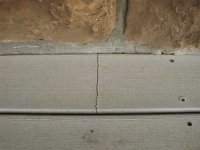Bear with me on this description, because moisture is important on this material.
I live on the Central coast of California, half way between LA and San Francisco, about 5 miles from the ocean. The temperatures will drop to 28 degrees and will sometimes hit the low 90's. It is generally fairly dry here, with heavy morning dew and afternnoon breezes to dry things up nicely. And of course, no snow or ice.
Around 14 months ago, I purchased and had installed about 2,850 linear feet of Trex tounge and groove 1 X 6 decking material. This decking is covered with a solid roof, but is open to wind and rain on one or two sides. This material WILL span 24" on center as the bottom of it is tressel like in structure and the material is fairly light compared to some other Plastic/fiber material. Keep in mind the only deck load will be a table chairs, benches, people and a rolling barbeque, nothing really heavy.
When I had it installed, they specified at least 12" above the ground level. I am approximately 27 - 30" above the ground. It lays on joists between two concrete stem walls. One at the edge of the house, the other at the outside patio edge which is at ground level or a little higher. There are weep holes every 12 inches. The deck itself is over a 27" high crawl space.
This product has mechanically failed in 14 months. While there is not a lot of rain, and I've only washed it off several times, moisture has apparantly been trapped under the deck causing it to cup, as much as 1/4" - 3/8" on some boards. The manufacture has indicatd there is a good chance they will replace the product and probably pay for the labor as well, because the don't want an unhappy customer on their new flagship product.
The manufacturer indicates that the failure was due to the fact that there was not adequate ventilation below the deck. The top and bottom would get wet, the top would dry quickly and bottom would not. The bottom would swell due to the moisture and the fact that with the tressel construction, there is more area on the bottom than the top.
This is not really a total PLASTIC product. It is product made from recycled plastic and WOOD fibers. Their ads called it a cellulite material, but the manufactures rep called it wood fibers and plastic. The wood holds the moisture and expands. It does not seem to shrink back after the damage is done.
When we installed it, there was not really an adequate explanation about the requirement for venting under the deck; just the distance from the ground which is the reason I believe the manufacturer will make it good.
The good side of this product: It requires no maintenance and the nails or screws do not show. It is fairly stable length wise. It is also slightly wider than standard 2 X 6 material so you need fewer board feet. It also does not come warped or split on the ends, so there is little waste. When installed over open areas such as second floor decks it seems to do OK.
The bad side: It is VERY EXPENSIVE, nearly twice that of redwood. It also seems to stain quite easily from water from the hose or rain. When it did cup, it would pull right through the screw heads and does not seem to return to a flat surface when it dries.
I may or may not replace it with anothe Trex product, but if I do, it will be shaped one more like conventional wood, with 16 penny spacing between planks and screws down through the top. I need to dome some more research.
If themanufacturer covers it, I'm OK, if not, I'm out probably $6,000 - $7,000 in material plus the labor. /forums/images/graemlins/mad.gif
The bottom line, while the weather conditions should not have been a factor, and while I can't whole heartedly endorse it, if properly installed and with good venting, it will probably do OK.
As far as using this product to cover the existing decking, I would say an absolute NO WAY.
I hope this information is helpful. Good Luck.
Joe

